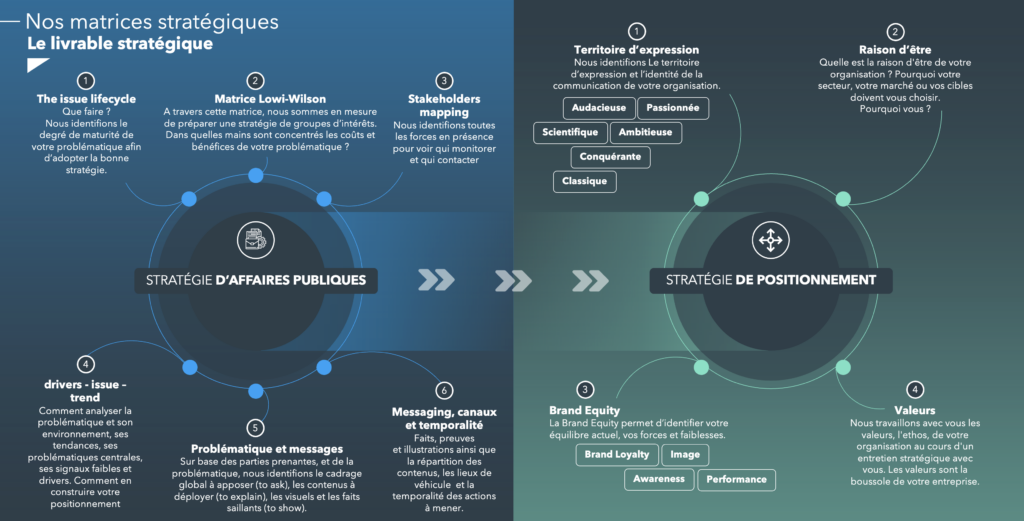Contents

Public affairs and societal issues: what matrices are needed to understand them?
The teaching of public affairs is so outdated ("Read Hobbes' Leviathan") that people in communications or marketing often have the image of dinosaur consultants before their time, wielding the surmulot through two applications: Word and Outlook.
However, there are a number of interesting theories and matrices that show just how theorised this profession can be, and just how far removed from caricature it can be for those who take a serious look at it.
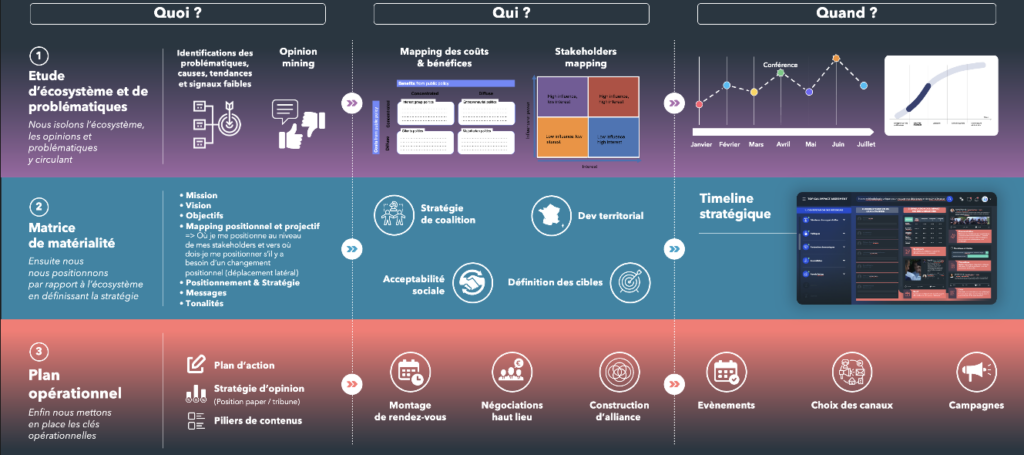
I. Matrices to see where you stand
There are three stages to a public affairs strategy:
- Identify needs and issues. What societal issues does a customer face? Who are the stakeholders in relation to the issues, the sectors or the organisation?
- Implementa resources strategy: here we're talking about who, what, where, how and when.
- Activation. The stage that everyone knows about and that 80% of customers want without the other two stages. And yet, too many people in management think that all it takes is Emmanuel Macron's 06 to get the ball rolling. But no.
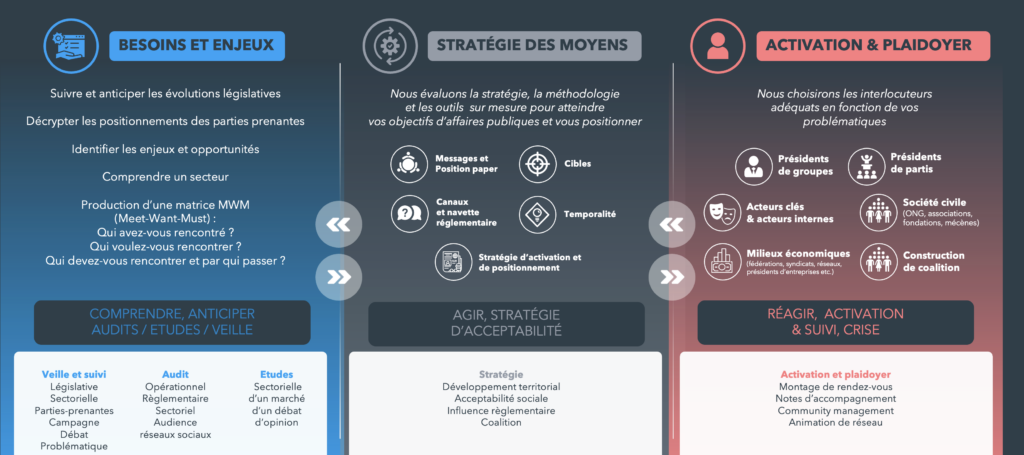
a) The life cycle of an issue: we focus on the what
Once you've identified the issues around your customer, you need to identify where they are in the life cycle of the issue. This has 5 successive stages, which we will illustrate with a scooter:
- Emergence of the issue: this stage corresponds to the emergence of a new issue or problem which begins to attract the attention of stakeholders (public, media, experts, etc.). This may be the result of new technologies, social or economic changes, or any other factor that creates a need for regulation or political action.
- Electric scooters are suddenly appearing in major cities, offering a new option for urban mobility but also creating problems of safety and management of public space. - Interest groups: at this stage, various interest groups (NGOs, consumer associations, companies, trade unions, etc.) take a stance on the issue. They seek to influence public opinion and political decision-makers through campaigns, research, events, etc. They seek to forge alliances
Scooter services will contact towns and cities to form mobility alliances, they will try to attract business leaders, or they will try to form alliances with street furniture operators to park their scooters. - Legislation: this is the stage when political decision-makers (parliamentarians, governments, etc.) begin to draft bills or regulations to address the issue. Debates and public consultations are often organised to refine the proposals. This is often when the lobbies wake up. They say "oh yes, there's a law?" and in 3 weeks they try to respond to an issue that has been around for years.
The unions, seeing the alliance with the scooter services, are going to ban the replacement of the navigo pass with scooters, the scooter player who has formed an alliance with a street furniture player is going to try to ban free-floating, and so on. - Judicial enforcement: Once laws or regulations have been adopted, it is crucial to ensure that they are applied. The courts can be called upon to interpret laws, resolve conflicts and impose penalties for non-compliance.
It is also possible to negotiate a period of appeal, a period of adaptation, as telephone operators do for roaming, etc. - Administrative implementation: this is the final stage where public administrations (municipalities, government agencies, etc.) take charge of the practical application of laws and regulations. This includes setting up monitoring systems, imposing penalties and organising information campaigns.
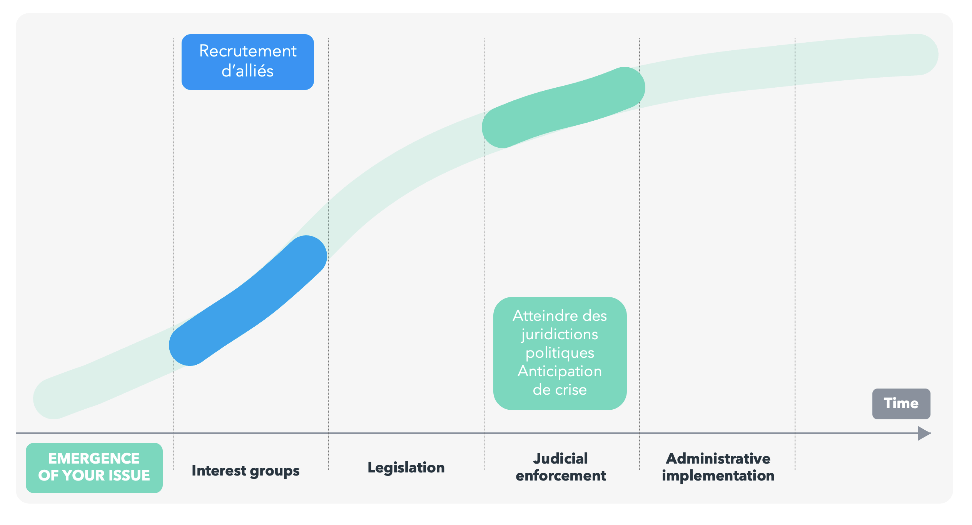
Depending on where we are, we will take the corresponding actions (raise the issue, try to put it to rest, make alliances, slow down the law, etc.).
b) Meet Want Must: where we stand on the who
Manon El Assaidi's Meet - Want - Must matrix is another way of focusing on the essentials.
- Meet: this stage involves identifying and analysing the stakeholders you have already met or with whom you are already in contact.
- Want: the list of people you want to consider.
- Must: selection of stakeholders to be activated.
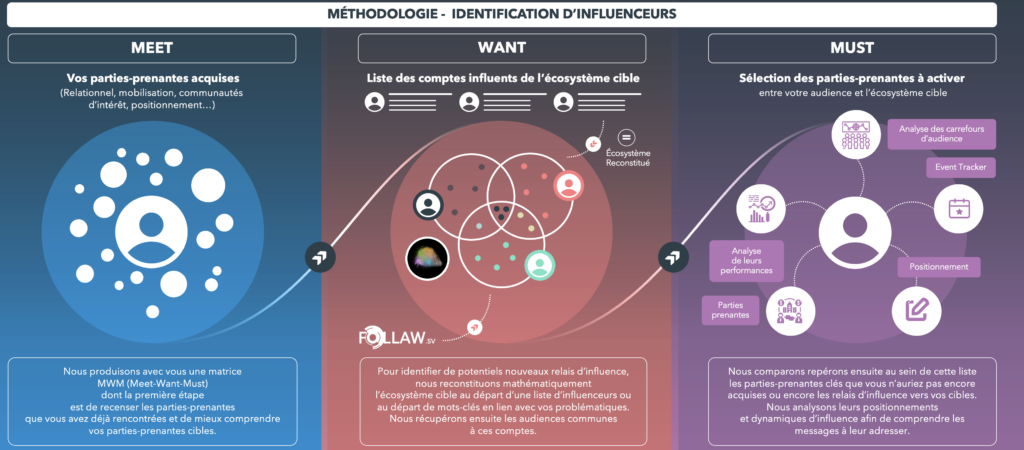
c) Event Tracker: we are on the when
We list all the events for the future period in order to prepare a back-plan.

II. Matrices to help with resources strategy
a) The Drivers / Issue / Trends matrix: why?
The Driver/Issue/Trends matrix is a tool used in public affairs to analyse and understand the dynamics of an issue. It provides an opening. For example, we can attack electric scooters by saying that they are the result of a fast-growing technology, linking them to AI or a whole host of other things. We could also include the resources that come from China or a whole host of other elements. This would allow us to map the entry points before any strategy.
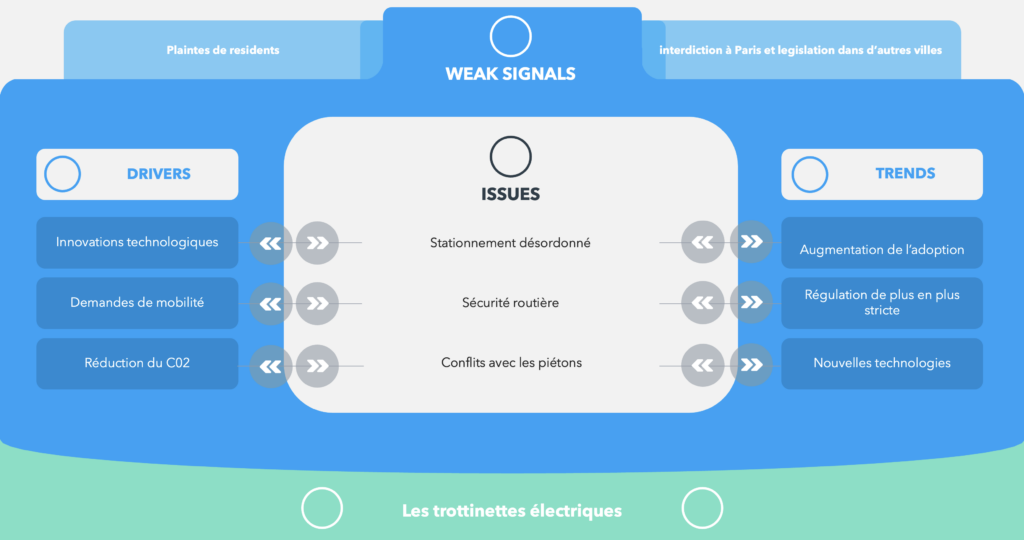
b) The Lowi-Wilson matrix: how it works
The Lowi-Wilson matrix assesses public policies according to the distribution of costs and benefits, classifying them as concentrated or diffuse.
1. Concentrated benefits, diffuse costs: that's the policy we hate. It's the kind of politics that we hate. In public affairs, we try to raise political awareness in closed areas without mobilising the media.
2. Concentrated benefits, concentrated costs: policies of this type can lead to intense conflict between the beneficiary groups and those who bear the costs. In public affairs, you mobilise your entire sector to give the illusion that it will bring a lot of benefits. All the while hoping that those who pay will be slow or no good.
3. Diffuse benefits, concentrated costs: This type of policy can be difficult to implement because those who bear the costs are often very opposed, while the diffuse beneficiaries are less motivated to defend the policy. In public affairs, this should be self-evident to decision-makers, and mobilisation is required through petitions or extensive media coverage.
4. Diffuse benefits, diffuse costs: It's WAREEE! All means are mobilised.
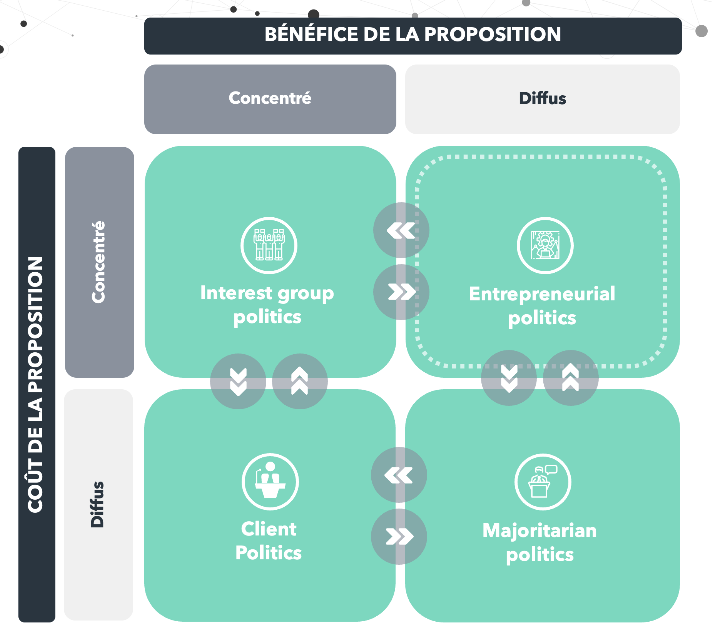
This will help us to identify the entry point and the resources required.
c) Stakeholder mapping: who are we targeting?
We won't insult you by explaining what stakeholder mapping is. At most, if a student comes along, we'll tell him that we're mapping the people who are linked to the issue on the basis of whether they have power or interest.
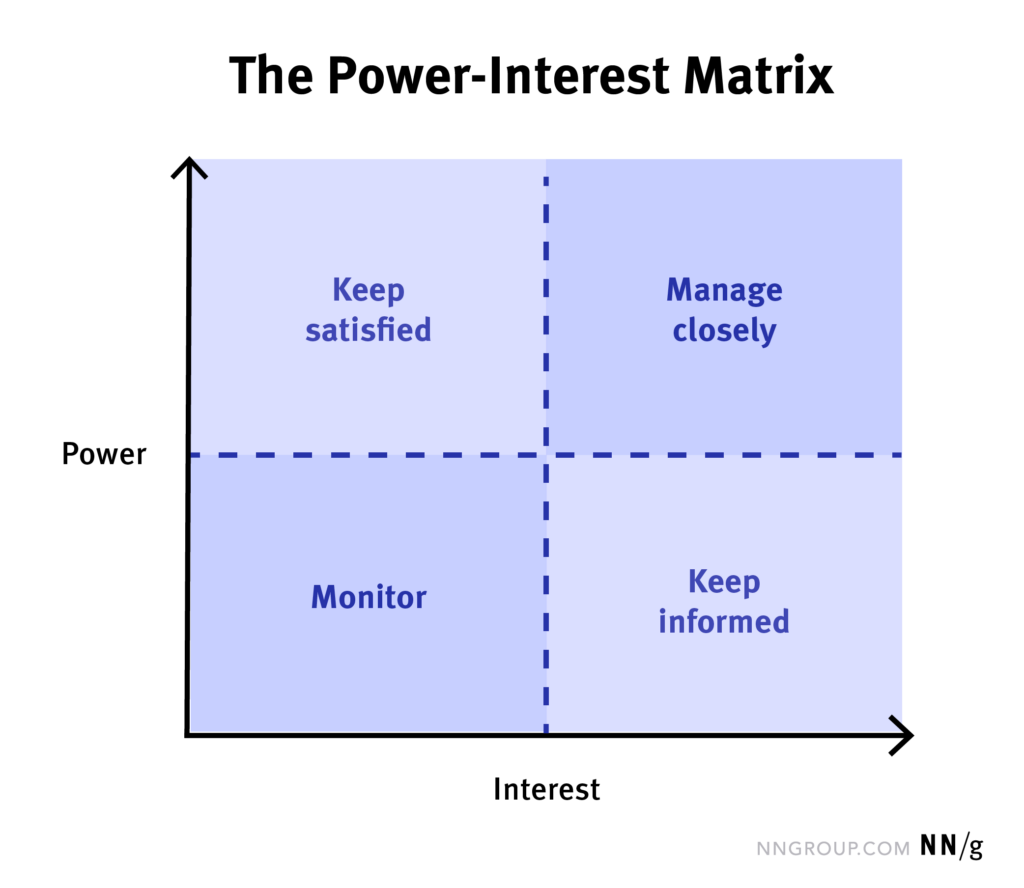
III. Don't forget the two secret ingredients: data and all the weapons at your disposal
And in all this, a matrix is nothing without information gathering. So we gather all the information with all the software. Then the human element comes in to contribute its know-how, and visualises it through the strategic matrices that we have seen together.
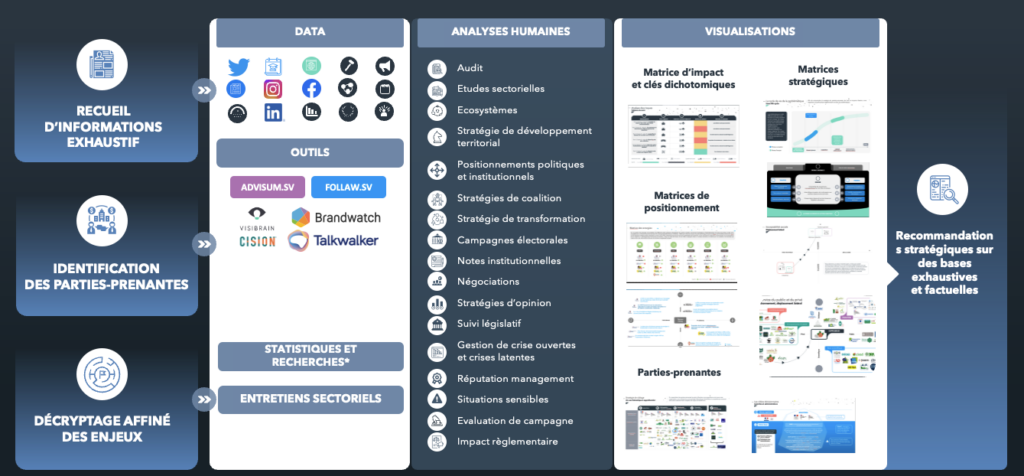
And just with the public affairs toolbox, we have an incomplete scheme: so we need to develop the software. And to do that, we need to mobilise all the disciplines: communications, marketing and others. In short, it's all so complex that it's hard to see how we can remain a dinosaur in a world of total change, where everything is speeding up and becoming more professional.
